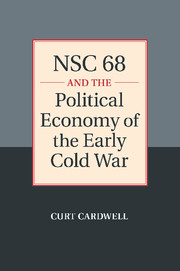Book contents
- Frontmatter
- Contents
- Acknowledgments
- Abbreviations
- Introduction
- 1 NSC 68 and the Problem of Origins
- 2 Multilateralism, the Soviet Threat, and the Origins of the Cold War
- 3 Multilateralism, the Dollar Gap, and the Origins of the Cold War
- 4 The Dollar Gap and Its Discontents
- 5 The British Sterling-Dollar Crisis of 1949–1950
- 6 The Origins and Development of NSC 68
- 7 The Political Economy of Rearmament
- Conclusion
- Select Bibliography
- Index
- References
5 - The British Sterling-Dollar Crisis of 1949–1950
Published online by Cambridge University Press: 05 July 2011
- Frontmatter
- Contents
- Acknowledgments
- Abbreviations
- Introduction
- 1 NSC 68 and the Problem of Origins
- 2 Multilateralism, the Soviet Threat, and the Origins of the Cold War
- 3 Multilateralism, the Dollar Gap, and the Origins of the Cold War
- 4 The Dollar Gap and Its Discontents
- 5 The British Sterling-Dollar Crisis of 1949–1950
- 6 The Origins and Development of NSC 68
- 7 The Political Economy of Rearmament
- Conclusion
- Select Bibliography
- Index
- References
Summary
The UK's collapse is one of the most dramatic events of recent history and the suddenness of that collapse has demonstrated the extent and depth of her former close association in the business and financial structure of Europe.
David K. E. Bruce, U.S. Ambassador to France, 1949United States foreign policy officials and other elites committed to multilateralism viewed the European Recovery Program (ERP), or the Marshall Plan, as a stop-gap measure designed to ease western Europe's dollar gap while more permanent solutions to it could be found. In the summer of 1949, however, it became clear to them that the Marshall Plan was not achieving its desired end as the dollar gap hit Britain with renewed force, causing it to dip into its gold and dollar reserves to purchase badly needed imports and, ultimately, to place trade restrictions on U.S. and other dollar area imports and begin contemplating autarchic solutions to overcome its economic woes. This, even as it was receiving Marshall Plan aid. The British crisis of 1949–1950 served as a wake-up call to Truman administration officials and their British counterparts that the dollar gap was a far more serious crisis than they had realized initially and that if something were not done to overcome it by 1952, the end year of the Marshall Plan, the western world would likely collapse.
- Type
- Chapter
- Information
- NSC 68 and the Political Economy of the Early Cold War , pp. 128 - 159Publisher: Cambridge University PressPrint publication year: 2011

